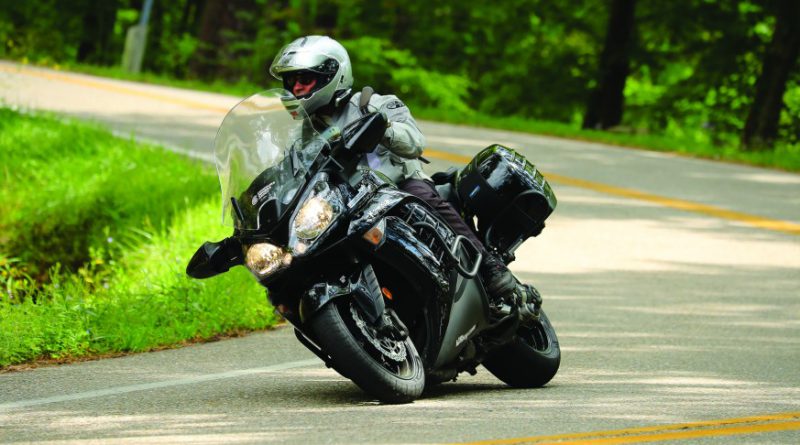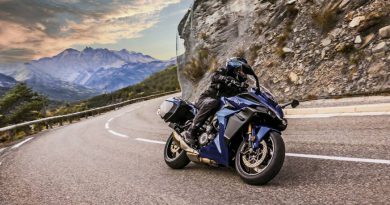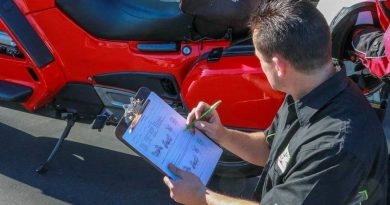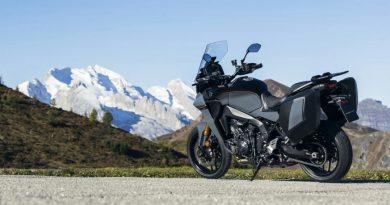Riding Tips for Twisty Roads
Sport Touring is about exploring America’s backroads, and the twistier the better. Motorcyclists seek out challenging roads as much as they look for interesting destinations to plan a tour around. Sometimes it’s hard to say which is more important. But getting the best from these technical roads takes an appreciation for motorcycle control and lots of practice.
Technical roads can be found from coast to coast. The Tail of the Dragon running along the state line between North Carolina and Tennessee is a canonical example among so many others. Iron Mountain Road in South Dakota, with views of Mount Rushmore, has some of the sharpest turns imaginable, some making a complete 360. And finally, near the Pacific Coast, there’s Angeles Crest Highway winding for 60 miles through the San Gabriel Mountains. Roads like these are all over the country and riding them is what it’s all about.
Technical roads like the Tail of the Dragon create an ideal environment to look at common mistakes and how to avoid them based on best-practice riding theory, control techniques, and of course a measure of lived experience. Novice riders and those who infrequently encounter tight twisties may find this most useful, but even experienced riders might appreciate a reminder.
A Word About Practice
Becoming proficient on twisty roads takes practice – lots of it. Those riders dragging a knee through the turn are well experienced. They put in the practice time. Some may even have had a crash. Learning to ride at the highest levels is a journey and for most one that only ends when they stop riding altogether.
Start at a pace that makes sense. One that is comfortable, maybe a little beyond that. When that feels too comfortable, dial it up a notch. Take the time to cement good bike control habits and undo the bad ones.

Riding technical roads should not be a race or time trial. After all, mastering any sport should be fun.
Understand Where You Are Riding
Many have seen the degree of difficulty scales in skiing and mountain bike riding, those symbols denote “beginner” or “expert” areas. Well, consider technical roads like The Dragon much like a double-black-diamond run; in other words, having a significant degree of difficulty rating. This is not to say that you cannot ride the road safely under any circumstances; of course, you can. However, the pace must be commensurate with your skill level and motorcycle cornering clearance.
Also, some of these roads may be popular with other motorsport enthusiasts, not just motorcycles. Expect sports car clubs to likewise work the twisty bits.
Do the Prep Work
They have a saying in Emergency Medical Services, “check your own pulse before checking the patient’s”. The same thing applies to riding technically challenging roads. You must have your head in the game. That means, understanding your current riding abilities and having no illusions of anything more.
Preparing includes getting needed rest. Riding 10 to 12 hours to a destination road and then immediately hitting the corners is a bad idea. Work out your route plan to hit the best technical roads when you are at your best. For some that may be first thing in the morning, others may be sharpest after an early ride and plenty of coffee. Either way, be as fresh as possible.

It goes without saying never omit protective gear no matter the daytime temperature. These roads are unforgiving. This is one time when ATGATT (all the gear all the time) is more than a suggestion.
Consider motorcycle preparation as well. Everything from general maintenance to tires, you name it. There is little margin for error riding remote twisty roads, especially at a fast pace. You must also know your bike’s capabilities. Some sport touring motorcycles are only a small step away from sport bike geometry and handling; others are longer and heavier with correspondingly less agility.
Read Up – Practice Up
Good riding, really good riding, takes a lifetime of practice. An enlightening first step includes reading books like Keith Code’s A Twist of the Wrist (Volumes 1 and 2); articles such as Nick Ienatsch’s The Pace – Separating Street from Track, Riding from Racing (Motorcyclist Magazine, February 2009) plus numerous other material online and in print. Most importantly, work to apply these good-practice theories into psychomotor skill development.
A brand-new rider on a brand-new bike is a recipe for serious problems on roads like these. Ride elsewhere first, develop good entry-apex-exit techniques on less aggressive turns. Even returning riders with some decent experience can benefit from refreshing skills before tackling this or other challenging roads of this type.
Hammer on the racetrack. Pace yourself on the street.
Nick Ienatsch, Founder of Yamaha Champions Riding School
Another great training opportunity is riding with an individual or a group who are more experienced and proficient than you. This is exactly how many riders improve. Most motorcyclists are more than willing to adjust their pace, allowing you to watch their lines and how they negotiate especially challenging parts. Doubly beneficial is if you have helmet communications, this is probably the best way to ramp your skills way up and do so in a very safe way.
One last thought about skilling up. Every rider, no matter how many miles in the saddle, will benefit from a well run track school. Schools are an excellent way to get help undoing bad habits and breaking through subconscious impediments that limit better and safer riding.
How to Avoid Mistakes
Consider these points about mistake avoidance on every technical twisty road you come upon.
Throttle/brake –Smooth is safe. Slow in, fast-out of turns. Hard throttle and hard braking between turns has no place in safe riding on these roads. As Nick Ienatsch accurately wrote, “Hammer on the racetrack. Pace yourself on the street.”
Focus on control, not speed – Upsetting chassis dynamics by braking mid-turn must be avoided. Braking is done with the front brake not the rear (again, training – read the books by the experts) preferably using the two-finger method, before the turn to set up the proper speed for entry; then throttle management to carry you through and out of the turn.
Ride with some cushion remaining – This means, not pushing to the maximum but maintaining a manageable consistency of speed and control. This keeps your traction and maneuverability within your budget in cases where evasive or emergency measures are required.
Braking vs sight distance – Your brake distance should never exceed your sight distance. Blind corners, rise-and-drops, anywhere you cannot see far enough to brake safely, you must scrub off speed to accommodate.
Go where you look, look where you go – Your sight picture must be as far through the turn or into the next turn even as you enter the first. Technical roads have many “S” curves, one after the other, so setting up for the next one is imperative. One major mistake on any curve is target fixation, or locking on to a fixed object, a rock, tree, or other object – or even at an oncoming vehicle. Your bike will go where you look, so look ahead where you need to go and not anywhere else. Remember from Basic Rider Training, head and eyes-up, turn your head and turn your eyes towards the target.
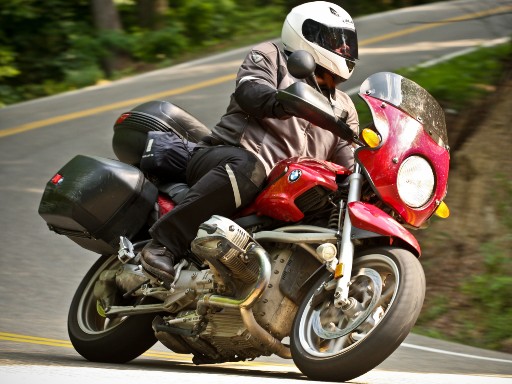
Use the entire lane when possible – Often, road debris or oncoming vehicles (many may cross the center line) reduce that width; however, entry-apex-exit strategies must be calculated and executed using all the real-estate available.
Ride fast enough to have fun, not to scare yourself – If you have that feeling of terror approaching a turn, you are going too fast, period.
Decreasing radius – Many turns start at one radius and aggressively decrease (get tighter). You must be prepared for that. Trust your bike and your tires. Running wide is not an option, therefore, you must practice throttle discipline and simply countersteer your way through. Yes, this means digging-in a bit more but with smooth, even throttle and no aggressive braking, your tires will hold. The bike is designed to lean and sometimes, lean far! Let the bike do what it is designed to do.
Don’t panic! – This goes with decreasing radius turns especially. Panicking causes brake stabbing and rapid throttle roll-off all of which upsets chassis dynamics and traction. You must train yourself to remain calm and in control. Experience helps, as does riding within your limits. Remembering your cushion (mentioned earlier) will help keep you off the panic button.
Ride your own ride – Trying to keep up with a faster rider out of ego or some other motivation will surely put you in harm’s way. Be honest with yourself about both your own and your machine’s capabilities.
Road conditions – These vary widely depending on the time of year and weather. Rainy, windy days are probably not a good time to ride any highly technical road. Wet leaves and tar snakes will consume your traction in a heartbeat.
A Few Final Points
Roads like Tail of the Dragon are entirely ridable by anyone on any bike. The operational variable is speed. That being said, it is important to also mention etiquette, those unwritten “rules” specific to especially twisty roads.
First, realize that you are likely going to be passed. Putting aside whether legal or not, someone faster will want to overtake you. Give them space by slowing down, moving over, and waving them by. This is a big deal with riders, for example on The Dragon and it goes a long way towards rider fellowship.
And secondly, cellular service in many of these mountainous, twisty areas is poor or nonexistent. Emergency services are thin; an ambulance can take 45 minutes or longer to arrive. If riding alone consider carrying an emergency beacon.
An Informed Rider is a Safer Rider
This material is not meant to dissuade anyone from riding these glorious twisty roads but rather as a reminder to do so safely. The reality is an informed rider is a safer rider. And sometimes safety is a rather harsh topic to cover honestly and directly; but not nearly as harsh as sliding across pavement. Embrace the opportunity to hone your safe riding skills and make every technical road the best experience it can be.
This article was derived from a piece written by Tom Batchelor and originally published in STAReview Magazine, a publication of the Motorcycle Sport Touring Association and is used with permission.
Did we hit the mark?
Click the Thumbs Up or Thumbs Down button to email your feedback.
Your questions and comments help improve American Sport Touring. Your email is not used for any other purpose. Please read our Privacy Policy.

